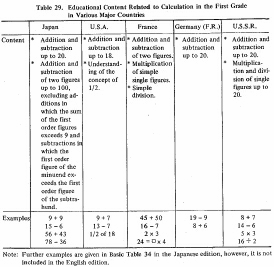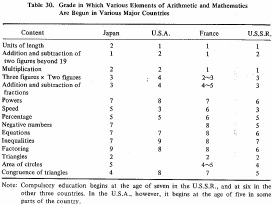| Home > Policy > White Paper, Notice, Announcement > White Paper > EDUCATIONAL STANDARDS IN JAPAN 1971 > CHAPTER |
||
In order to study educational attainments in various countries,
it is necessary to compare educational content as well as the variations in subjects
and teaching hours which have already been studied in the preceding section.
Although available data is limited, an attempt will be made to compare and study
the educational content covered in the subjects of arithmetic and mathematics
as taught in schools at the compulsory education level in various major countries.
(a) Educational content in the first grade of elementary school
In the countries considered, instruction in arithmetic starts with counting numbers of concrete objects, such as flowers and fruits, aiming at enabling pupils to count up To one hundred by the end of the first year, and addition and subtraction up to 20 is the central objective of calculations. In Japan, addition and subtraction up to one hundred is taught in the first grade, but additions in which the sum of the first order figure exceeds 9 or subtractions in which the first order figure of the minuend exceeds the first order figure of subtrahend are not included. Besides such addition and subtraction, simple multiplication and division are also taught in some countries. In France, multiplication of first order numbers and simple division are taught; in the U.S.S.R. division of numbers up to 20 and in the U.S.A. the concept of 1/2 are also taught. In Japan, division is not specifically taught, but the fundamental basis for multiplication and division is provided by instruction regarding groups of things and their equal division with the help of concrete objects.
Measurement of common objects is taught, starting with length and volume. In the U.S.A. and the U.S.S.R., pupils are educated to the extent that they understand such units as are commonly used in daily life. On the other hand, in France, West Germany, and Japan, pupils are instructed only to the extent that they understand the concept of quantity. In the U.S.A. and Japan, 'reading of clocks' is included in the curriculum. It, however, is at a rather simple level such as 'three o'clock' or' half-past four'.
Basic shapes are also included in the curriculum in several countries, although very briefly, while recently the elementary concept of set is being covered in France the U.S.S.R. and Japan.

In this section, the stage at which the main elements of arithmetic are begun will be studied briefly.
Almost identical tendencies can be seen in all the countries selected. In the U.S.A., however, basic shapes arc not included in the curriculum to any noticeable degree. Factoring is taught in the U.S.S.R. in the sixth grade (corresponding to the first year of lower secondary school education in Japan.). In Japan, however, this is started in the third grade of lower secondary schools.

Note: Compulsory education begins at the age of seven in the U.S.S.R., and at six in the other three countries. In the U.S.A., however, it begins at the age of five in some parts of the country.
The content of education at the elementary stage is almost the same in all the5electcd countries, although the stage at which the respective elements are begun is different from country to country. At the level of secondary education, however, each country has special features. These special features at the lower stage of secondary education are as follows.
Mathematics l13S been regarded as increasingly important and its content has been improved in various countries. In the U.S.A., emphasis has recently been placed on the systematic study of mathematics in order to help students develop basic scholastic abilities. Research on the modernization of mathematics teaching is rigorously being made. In the newly revised course of study in Japan, improvements will be made from the viewpoint of modernizing mathematics education. For example, 'set' will be included in the curriculum for the first grade of lower secondary schools, set structure, permutations, combinations and probabilities for the second grade, and sample surveys for the third grade.
In France, it is to be noted that practical measurement training called 'practice' is specifically provided in secondary schools. In France and the U.S.S.R., solid geometry and vectors are being taught. Pupils are also introduced to trigonometry in these two countries.
Many countries have recently' felt it necessary to achieve modernization of mathematics education and research on the introduction of abstract and applied mathematics at earlier stages in pupils' development are extensively being made.
| Back to Top | MEXT HOME |